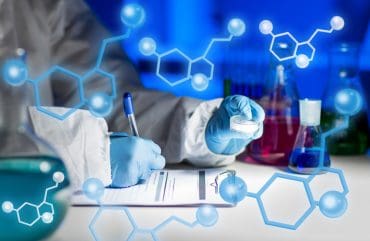
Generative AI models have the opportunity to lower the cost of drug development, while increasing the speed of discovery.
While the buzz around generative AI models is very consumer-driven at the moment, with ChatGPT and DALL-E showcasing AI’s potential, researchers are also trying to work these systems into drug discovery and other pharmaceutical research efforts.
One of these, DiffDock, uses a diffusion generative model in the same vein as DALL-E and Midjourney to accelerate the pace of drug discovery while reducing the likelihood of side effects.
SEE ALSO: A Primer Into Generative Text-to-Image Systems
Introduced by a team of researchers at MIT’s Jameel Clinic for Machine Learning in Health, the generative AI model has the capability to change the drug development pipeline, by removing the need for state-of-the-art computational design tools which pharmaceutical research labs use and increasing the rate at which a drug can be developed and synthesized.
At the current rate, the development time of a drug to treat certain types of cancer averages over a decade and 90 percent fail at the clinical trial stage. Some estimates put the total development cost at $1 billion to $2 billion per drug, a rather astonishing rate and one of the key reasons why pharmaceutical companies are looking at AI as a potential tool to reduce costs.
“DiffDock makes drug target identification much more possible. Before, one had to do laborious and costly experiments with each protein to define the drug docking. But now, one can screen many proteins and do the triaging virtually in a day,” said Tim Peterson, an assistant professor at the University of Washington St. Louis School of Medicine. “There is a very ‘fate loves irony’ aspect that Eroom’s law — that drug discovery takes longer and costs more money each year — is being solved by its namesake Moore’s law — that computers get faster and cheaper each year — using tools such as DiffDock.”
Generative systems have a lot of advantages in the discovery and development stage, as it can provide hundreds or thousands of different answers to a single query. “With generative modeling, you assume that there is a distribution of possible answers — this is critical in the presence of uncertainty,” said Gabriele Corso, co-author of the paper and affiliate of the MIT Computer Sciences and Artificial Intelligence Laboratory.
DiffDock, like many other AI drug discovery systems coming online, was partly inspired by the launch of AlphaFold, the huge protein structure database. Insilico Medicine and the University of Toronto showed the power of combining AlphaFold with generative systems, reducing the time to develop a drug to treat primary liver cancer down to 30 days.
Moving from state-of-the-art molecular docking tools, which have been standard practice for pharmaceutical labs for decades, will be a lengthy process. We expect academic research labs and machine learning researchers to be the first to show the value of generative AI in drug discovery, before the industry invests heavily into it.



























